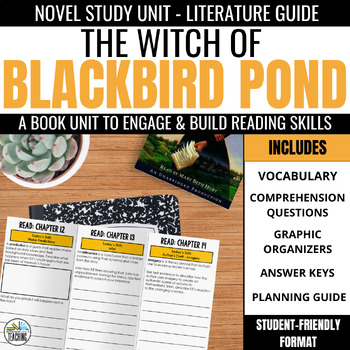The Witch of Blackbird Pond Novel Study
- PDF
Description
This 4-week novel study unit for The Witch of Blackbird Pond by Elizabeth George Speare is ideal for 5th, 6th, or 7th grade classrooms and will save hours of planning for your book unit. Daily comprehension activities make great discussion questions and require students to focus on text analysis and responding to literature without overwhelming them with countless chapter questions that have learners regurgitate the text.
The Witch of Blackbird Pond is a great book for your next literature unit or book club. The book and this printable novel study unit will engage readers while you cover important comprehension skills & vocabulary without losing precious planning time. With this Witch of Blackbird Pond novel study, you'll have more time to do what you love: teach.
Standards-aligned & perfect for novel studies, small group book clubs or lit circles, independent reading, or monitoring and teaching during read-aloud.
Your download includes:
✔ Daily comprehension prompts in 2 formats for differentiation
- Foldable trifold brochures
- Cut & paste journal prompts for interactive notebooks
✔ Weekly word of the day flip books for text-based vocabulary
✔ Easy-to-follow directions for printing & prep
✔ Instructional planning guide
✔Answer keys
In this The Witch of Blackbird Pond Novel Unit, you'll find:
1) Student comprehension practice (up to 20 instructional days)
- Each day's work focuses on a single standards-based comprehension skill
- Short, written responses include opportunities to apply thinking to text
- Designed with reluctant and struggling learners in mind
- Built-in graphic organizers to support skill acquisition
- Approachable questions help make connections & start conversations
- No boring multiple-choice or fill-in-the-blank questions!
- Available in both printable trifolds and reading journal prompts
2) Approachable practice with key reading standards and skills, including:
- Generating a summary of key events
- Explore suspense and foreshadowing and their impact on the reader
- Plot analysis from the perspective of self & characters
- Examining character development, motivation & relationships through plot and dialogue
- Analyzing internal conflict & external conflict and how they carry the plot
- Exploring the author's use of imagery
- Identifying and supporting theme
- And so much more!
3) Text-based & academic vocabulary
- One target word identified for each day's reading
- A flexible foldable format allows for the study and application of new vocabulary
- Opportunities to make connections to academic vocabulary for daily skills
4) Teacher support materials
- Unit scope & sequence lay out the day's comprehension & vocabulary focus
- Answer Keys for all comprehension activities
- Tips for preparation and implementation
-------------------------------------------------------------------------------------------
How Novel Units from Differentiated Teaching Work...
▸ Teachers can introduce the day's vocabulary word & discuss before reading.
▸ Students complete just one section of the trifold or a single Google Slide each day.
▸ Daily work focuses on target skills needed for success in reading vs. plot recall.
▸ The low-pressure format provides novelty & encourages student engagement
▸ Less overwhelming to reluctant readers and writers
▸ Requires deep analysis and application of text-based knowledge
▸ Encourages discussion about skills & strategies
Here's why teachers love these novel units...
♥ We used these for a whole-class novel study. Pre-printed brochures fully encompassed ELA skills for the novel. This is an extremely easy, but very rich set of activities for understanding and enriching student's ELA skills. I will be using this for our first novel study again in class this fall. I highly recommend this! -Allison M.
♥ This has helped me so much in teaching Holes to my students this year. Other resources overwhelm students with too much vocabulary and literal comprehension questions but these slides give students one vocabulary word for each chapter and a grade-level higher-order comprehension skill to practice. - Kristin P.
♥ I LOVE the layout and how it guides my son and I through our reading time. As a homeschool parent, I still wanted to give him that opportunity to discuss and grapple with the text and I love this quick format as a brochure. I also love the vocab focus for each section and the skill listed so I can monitor his understanding of these as we move through a variety of texts this year. - Antonia S.
-------------------------------------------------------------------------------------------
Other Novel Studies You May Enjoy:
-------------------------------------------------------------------------------------------
Terms of Use:
© Rebecca Davies. All rights reserved by the author. These materials are intended for personal use by a single classroom only. Copying for more than one teacher, classroom, department, school, or school system is prohibited. For use in multiple classrooms, please purchase additional licenses. This product may not be distributed or displayed digitally for public view. Failure to comply is a copyright infringement and a violation of the Digital Millennium Copyright Act (DMCA). Clipart and elements in this PDF are copyrighted and cannot be extracted or used outside this file without permission or license. See the product file for clip art and font credits.





